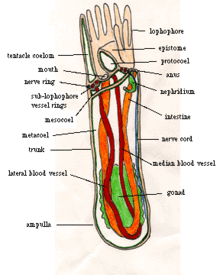Horseshoe worms
| Horseshoe worms | ||||||||||||
|---|---|---|---|---|---|---|---|---|---|---|---|---|

Phoronis hippocrepia |
||||||||||||
| Systematics | ||||||||||||
|
||||||||||||
| Scientific name of the tribe | ||||||||||||
| Phoronida | ||||||||||||
| Hatschek , 1888 | ||||||||||||
| Scientific name of the family | ||||||||||||
| Phoronidae | ||||||||||||
| Hatschek, 1888 |
All 15 species of horseshoe worms (Phoronida) living today belong to the two genera Phoronis and Phoronopsis , which belong to the family Phoronidae.
Horseshoe worms live in tropical and subtropical seas. They live in chitin tubes interspersed with foreign bodies , often in association with cylinder roses in marine sediments at depths of up to 400 meters.
The name "horseshoe worms" refers to the characteristic, U-shaped curved tentacle apparatus with which the animals filter their food. This tentacle apparatus is called the lophophor organ (gr. Lophos "head of hair"), the lophophor is the U-shaped support on which the individual tentacles sit. A similarly built tentacle wreath around the mouth opening can also be found in the arm pods (Brachiopoda) and bryozoa , therefore these two groups were often combined with the horseshoe worms as a large group Lophophorata or Tentaculata (wreath probe). This relationship hypothesis could only be partially confirmed in molecular biology. Horseshoe worms and arm pods are therefore sister groups, various names such as “ Brachiozoa ” and “Phoronozoa” have been proposed for this taxon . The third traditional “Lophophorata” group, the moss animals, do not seem to be closely related to the other two lines.
anatomy
Species list
- Phoronis ovalis
- Phoronis hippocrepia
- Phoronis ijimai
- Phoronis australis
- Phoronis muelleri
- Phoronis psammophila
- Phoronis pallida
- Phoronopsis albomaculata
- Phoronopsis harmeri
- Phoronopsis californica
- Phoronopsis malakhovi
See also: Systematics of the animal kingdom
